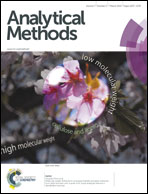Determination of seven anticoagulant rodenticides in human serum by ultra-performance liquid chromatography-mass spectrometry
Abstract
A rapid, sensitive and selective method for simultaneous determination of seven anticoagulant rodenticide residues (warfarin, coumatetralyl, diphacinone, chlorophacinone, brodifacoum, bromadiolone, and flocoumafen) in human serum by ultra-performance liquid chromatography-mass spectrometry (UPLC-MS) has been developed and validated. Serum sample preparation was carried out rapidly and effectively by one-step protein precipitation and analytes extraction using methanol containing 10% acetone. Chromatographic separation was achieved within 10 min using a BEH C18 column (1.7 μm, 2.1 mm × 100 mm) and gradient elution with the mobile phase of 5 mM ammonium acetate aqueous solution–methanol. Good linearity was achieved over three orders of magnitude with a correlation coefficient (r2) of 0.9924–0.9994. The limits of detection for the seven rodenticides ranged from 0.06 μg L−1 (flocoumafen) to 1.5 μg L−1 (diphacinone). The intra- and inter-day relative standard deviations (RSDs) of the seven analytes at the three spiked levels (1 × LOQ, 5 × LOQ and 10 × LOQ) were in the range of 0.6–10.3% and 5.1–15.1%, respectively. The mean recoveries for the seven analytes at the three spiked levels (1 × LOQ, 5 × LOQ and 10 × LOQ) were in the range of 77.3–98.2% with RSDs of 0.58–11.1%. The proposed method was successfully applied for the analysis of the seven anticoagulant rodenticides in human serum.


 Please wait while we load your content...
Please wait while we load your content...